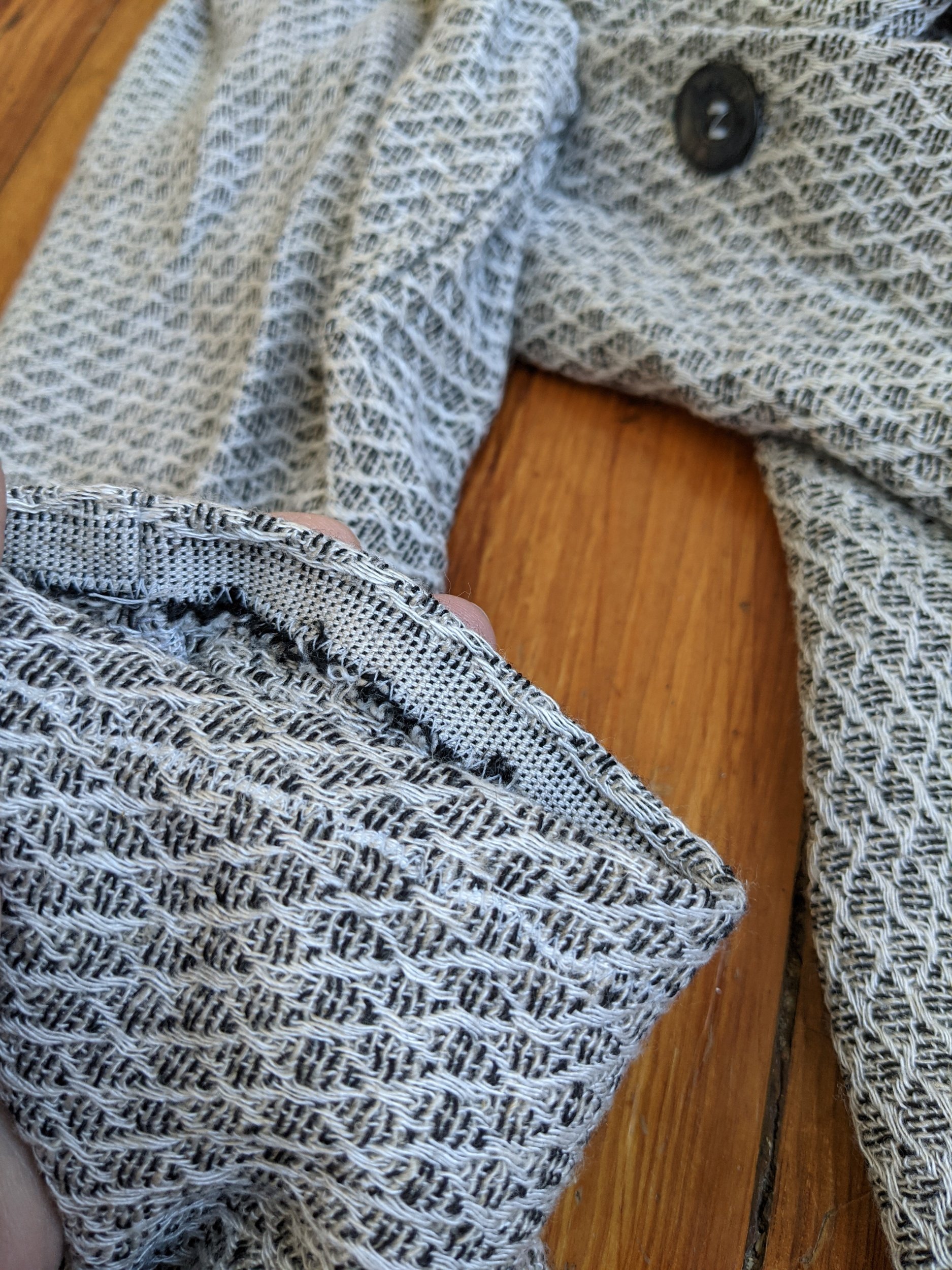StitchFix-Inspired Coram Sweater
Dare I say, I actually love targeted ads. Every now and then, they drop a gem in my lap so inspiring that I spend the next few days strategizing how I’m going to recreate the look. Take this sweater from a StitchFix ad-
Gorgeous, eh?!
About the same time this ad image started following me around on social media, Nikki of GreenEnvyCraft had reached out about working together. She offered me my choice of fabric and buttons from her shop in exchange for a guest post on a blog she’s launching. Naturally, I took her up on the offer and chose this rayon/flax texture extravaganza that we dubbed The Luxurious™.
The Luxurious™, while giving off all the sweater vibes with its loose texture, is technically woven. I initially wasn’t quite sure how to tackle this sweater/not-sweater fabric.
Queue the lightbulb moment! The StitchFix dupe rolling around in my grey matter could be born of The Luxurious™ (Nikki had even sent the perfect buttons!). The solution was a pattern deep in my pattern vault, Coram.
Coram (Allie Olson) checks three key boxes-
raglan style
drafted for woven (non-stretch) fabric
curved, “dolphin hem”
I had purchased the pattern way back in 2017 as part of a “mini collection” curated by IndieSew, which dissolved a few years back. (crocodile tears emoji) That’s neither here nor there, as Allie Olson’s label endured and her patterns have since been updated and expanded.
Pattern changes needed-
eliminate the bust dart
lengthen the back*
create hem facings/side seam plackets
lengthen sleeves to wrist
Upon request, I’m trying to incorporate more side boob in my posts.
Actually, one of the times I sewed Coram for a fabric tour, there nearly was side boob, because I missed the lower notch. (That embarrassment is here, towards the end.)
And we’re back!
In addition to the inspiration sweater not having bust darts, I simply didn’t want to sew them in this fabric. The fit is relaxed and fabric is sufficiently drapey. Also, I wanted to lengthen the back. I’m sure it’s technically wrong (you’re welcome to tell me so), but what I did was take the dart uptake (2 inches) out of the length (at the waist) straight across and pretend it never happened. With the front shortened, the back was effectively lengthened.
For the facings, I traced the front and back pieces from under the arm through the hem, 2 inches wide. That width was sufficient for a substantial placket and seam allowances. I cut the facings from tricot interfacing as well.
My approach to the sleeves was to add the length I measured would need to be added, tapered to the finished width I wanted for the wrist. Looking at the modeled photos, I think the sleeves could be slimmed a bit.
The sleeve head has a dart which I’m more or less ignoring in this post. I sewed it as is since I didn’t feel the need to look into eliminating it.
The post I wrote for GreenEnvyCraft covers several tips for success when using loosely woven or shifty fabrics and will appear on her site. (I'll drop a link here once published.) One of those tips was to use the selvedge when possible since it should be stable and finished. Here's a peak inside the sleeve hem as an example.
The pattern changes also changed up the construction order somewhat. In a nutshell-
finish inner edge of facings (I serged and turned to the wrong side.)
add front and back facings, right sides together, clip curves, turn to wrong side and edge stitch in place
overlap the plackets, back over front at the side seams, baste together at the under arm
close sleeve side seam
attach sleeves to bodice along raglan seam
label from Kylie and The Machine
Finishing the neckline was the last hurdle. In the Coram pattern, a strip of bias is applied in a similar fashion to knit neckbands. I decided to just take that approach, though in adding some interfacing to my band, I eliminated any mechanical give it might have had. As such the neckband looked too long, standing up too much. Rather than remove it, I turned the band once to the inside and eased the sweater a bit at the stitching line while sewing it down so it curves as best as it can. It’s essentially a French bias binding and it lays reasonably well.
Those buttonholes are functional! My machine was only unhappy about the highest ones as they are too close to the underarm seam where it’s bulky. The tops ones are faux, which is just fine. No one needs to see my side boob.
Now, please enjoy several modeled images in which I try to highlight the button placket and curved hem.
I LOVE it. It’s like wearing a cozy cloud and the style feels very “me.” While I used very light tricot, the hem facings are just a tad stiff, so I’m hoping they soften a little with wear and laundering.
Thanks, Zuckerburg and team, for the inspiration. And thank you, Nikki, for the fabric and buttons!
I’m leaving you with a bonus, behind the scenes photo my daughter insisted on taking. That’s some real life in the background, eh? Laundry baskets and such.
* Addendum-
“View A (top) features a hi-low hem.”
The top view for Coram always featured a back longer than the front. One would need to remove a length greater than the dart uptake to adjust the relative length of the front to back.



















